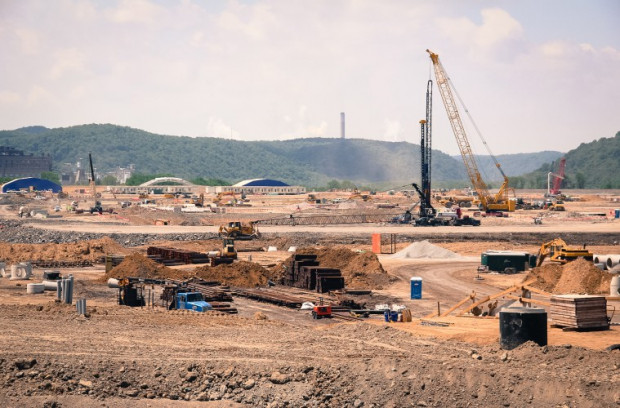Pennsylvania could support four more ethane crackers, report says
-
Jon Hurdle

Reid Frazier / The Allegheny Front
The construction site for Shell's ethane cracker in western Pennsylvania. A new report says Pennsylvania could support four more similar facilities.
Pennsylvania has the capacity to attract up to four more ethane cracker plants because of its abundant reserves of natural gas liquids (NGLs) and its proximity to major markets for plastics feedstock, a report released by Gov. Tom Wolf’s office said on Tuesday.
The report from the consultant IHS Markit projects that more petrochemical companies could decide to invest in Pennsylvania, following the lead of Shell Chemicals which is building the state’s first ethane cracker plant in western Pennsylvania to take advantage of NGLs from the nearby Marcellus and Utica Shales.
The need to develop the supply of NGLs from shale beds could also draw investment of $2.7 billion to $3.7 billion, the report said.
“Pennsylvania currently has a sufficient supply of NGL to support a world-class petrochemical industry,” it said. “Its major competitive advantage is access to an expanding supply of low-cost natural gas and NGL (particularly ethane and propane) capable of supplying up to four additional world-scale, integrated ethane crackers similar in size to Shell Pennsylvania Chemicals.”
The report was paid for by the Team Pennsylvania Foundation, a nonpartisan nonprofit that works to boost economic growth through public-private partnerships. It is currently chaired by Gov. Wolf and Stephen Tang, head of the University City Science Center in Philadelphia.
J.J. Abbott, a spokesman for Wolf, declined to say how much the study cost but that no public funds were used. He said there are no new petrochemical projects about to be announced.
“At this point, we do not have any specific projects or new support initiatives to announce. Any business development incentives offered are based on size and scope of the project and commitment to new job creation,” Abbott said.
In June 2016, Shell Chemical announced its plans to build the ethane cracker – which will make feedstock for plastics manufacturing – in Beaver County, about 30 miles northwest of Pittsburgh, at an estimated cost of $6 billion.
The announcement of the large-scale plant ended several years of speculation about whether the plant would actually be built, and follows tax breaks provided by the Wolf administration.
The plant, which is due to begin operation in the early 2020s, is expected to create some 6,000 jobs during construction and 600 permanent jobs.
Wolf said the new report shows that Pennsylvania can build on Shell’s project.
“The foundation for building a diverse and robust petrochemical and plastics industry was initiated with the decision by Shell Chemicals to invest in Pennsylvania,” Wolf said in a statement on Tuesday. “We must ensure that we make the most of this chance to create good-paying jobs for Pennsylvanians.”
The state produced about a quarter of U.S. natural gas output in 2015 and that’s expected to increase, along with NGLs, through at least 2030, the report said. It noted that some 70 percent of the liquids are the ethane and propane that are needed by petrochemical companies like Shell.
In addition, NGL-rich southwest Pennsylvania is within 700 miles of two-thirds of the U.S. and Canadian demand for the polyethylene and polypropylene that are needed for plastics manufacturing, the report said. It noted that there is sufficient demand from plastics manufacturers already in Pennsylvania to take some output from the new Shell plant.
The state’s costs for petrochemical manufacturers are competitive with those in its major competitor, the U.S. Gulf Coast, the report said.
To take advantage of the favorable conditions, the state should invest in more NGL pipelines and storage capacity as well as investing in sites where well pads can be built, the report said.
“IHS Markit recommends that Pennsylvania take aggressive action to address potential developmental and infrastructure constraints proactively,” the report said.
Rob Altenburg, director of the Energy Center at the environmental group PennFuture, said the report focused on the technical potential of the state’s shale reserves but did not consider the environmental effects of a massive increase in the petrochemical industry.
“What are the environmental costs going to be of importing this much new infrastructure into the state?” Altenburg said. “We didn’t see any evaluation of where this would put us in fighting climate change and how this will stress local communities. It seems like we’re only getting half the story right now.”
But Patty Horvatich, Vice President of Business Investment at the Pittsburgh Regional Alliance, an economic development organization that played a key role in negotiating with Shell, said the projection of several new cracker plants was a credible estimate from an organization that advises some of the biggest petrochemical companies in the world.
The report builds on work that local business organizations have been doing, she said. “Having this compilation of information is a road map for us,” she said. “We had been advised that there is room for more, so having a number is very good.”
The Alliance and its partners in the Allegheny Conference are talking with potential investors, Horvatich said.
“We’re charged with marketing the region, and we’ve been talking with some of the largest petrochemical companies in the world,” she said. “There are a lot of companies paying attention to our region right now.”
She declined to characterize the status of discussions or say whether any of the parties might be interested in building another cracker plant.
Asked whether there are enough pipelines in Pennsylvania to carry the increased volume of natural gas liquids that would be needed for new cracker plants, Horvatich predicted that investors would ensure that capacity was sufficient. “The mega-corporations are going to make sure that there’s pipeline to move it,” she said.
















